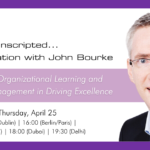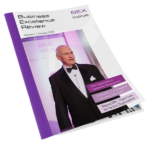The Business Excellence A to Z

Agility
An organization’s ability to rapidly, efficiently, and effectively adapt to change.
Approach
The overall way by which something is made to happen. An approach consists of processes and structured actions within a framework of principles and policies.
Balanced Scorecard
A performance management and strategy communication tool that can be used to track and reward progress towards organizational objectives (conceived by Robert Kaplan and David Norton in the early 90s).
Benchmarking
A systematic comparison of approaches with other relevant organizations, which provides insights that can help the organization take action to improve its performance.
Black Swan
A metaphor for an unpredictable event – an “outlier” – that we do not expect (since nothing in our experience has given us no reason to), which has a very major positive or negative impact and which, in retrospect, hindsight bias makes us think was predictable. It was first used by Nassim Nicholas Taleb and is also a salute to philosopher Karl Popper.
Business Excellence
Organization-wide excellence that supplements Operational Excellence with excellent strategy, communication with all stakeholders, and – critically – results.
Business Model
The elements of the business that create and deliver value. These normally include the value proposition, the profit formula, key resources and key processes of the organization.
Business Stakeholders
The people who provide funding for the organization and to whom the Management Team ultimately report. Depending on the nature of the organization, this could be the shareholders, partners or, in the public sector, the government, ministers or other politicians (see also: stakeholder).
Capability
The quality of being able to turn capacity into action and results by accessing relevant knowledge, competence, expertise, resources and processes.
Capacity
A measurement of what can theoretically be achieved, usually expressed in terms of size, volume or number. In organizations, this often refers to what the theoretical maximum output is compared to what the actual output is, with the result being expressed as a percentage.
Change Management
An approach for leading the transition of individuals, teams and organizations from their current state to a defined, desired future state. It is an organizational process aimed at helping stakeholders affected to accept and embrace changes in their business environment.
Common Cause
A cause of variation that is inherent in a process or system of processes. Failure to distinguish between special causes and common causes when taking action, results in frustration, waste, and greater variability.
Comparisons
Data used to compare the performance of one organization or process with another.
Continual Improvement
The ongoing improvement of processes that lead to achievement of higher levels of performance through incremental change.
Control Limits
Statistical calculation of the natural variation, based on the observed level of deviation from average, in a process. Under normal conditions, results will fall between the upper and lower limits calculated. Data points outside these limits are normally the result of a “special cause”; something exceptional has happened.
Core Competence
An internal activity or capability that is central to the organization’s competitiveness, profitability or efficiency.
Core Process
The key activities undertaken by the organization to create value for its customers.
Corporate Governance
A framework of authority and control within an organization used to help it fulfill its legal, financial and ethical obligations, helping to ensure accountability, fairness and transparency in an organization’s relationships with all its stakeholders.
Corporate Social Responsibility
Corporate citizenship whereby an organization considers its responsibility to the community and environment(s) in which it operates and takes responsibility for its actions to ensure positive impacts for all its stakeholders not just its customers, people, and shareholders.
Cost Benefit Analysis
A systematic approach to estimating the potential benefits of a course of action compared to the costs incurred by taking that action.
Creativity
The generation of ideas for new or improved products, services, processes, systems or social interactions.
Critical Success Factor
Something without which a successful outcome is impossible and for which no substitute is available. Often abbreviated to “CSF”.
CTQ / Critical to Quality
A structured approach for determining the factors that, from the customer’s perspective, are critical to the quality of the end product or service being delivered.
Culture
The specific collection of Values and Norms that are shared by people and groups in an organization that control the way they interact with each other and with stakeholders outside the organization.
Customer
The recipient of products or services provided by the organization.
Design Thinking
An iterative approach to design, originally from architecture, that was adopted by business for product design in the 90s. In contrast to analytical thinking, which involves breaking things down, design thinking works to build ideas up, and typically follows a 7 step process of: define, research, ideate, prototype, choose, implement, and learn.
Diversity
The state of being composed of people who are different and extent to which the people within the organization recognise, appreciate and utilise, the characteristics that make individuals unique. Diversity can relate to age, race, ethnicity, gender, beliefs, professional background, physical abilities & sexual orientation.
DMAIC
Acronym derived from “Define, Measure, Analyse, Improve, Control”; a structured process management approach commonly used in Six Sigma / Lean Six Sigma.
Employability
A person’s capability for gaining and maintaining employment. The meaning can be different depending on the perspective taken. For the individual, this could mean stability or mobility. For the organization, it could mean flexibility.
Empowerment
The process by which individuals or teams are able to take on decision making responsibilities and operate with a degree of autonomy in their actions.
Enabler
Something that enables an organization to achieve results. Enablers are things that an organization can influence directly and acting on them produces a knock-on impact on the results the organization achieves for its various stakeholders.
Equal opportunity
The practice of ensuring that all people receive fair and equal treatment regardless of gender, age, race, nationality, religion, disability or sexual orientation.

Kaizen
Japanese word meaning “continuous improvement”, commonly used to describe on-going improvement activities in the workplace that leverage the input of people from all areas of the organization.
Kanban
An operations management system that focuses on reducing inventories and Work In Progress, having things ready “just in time” for when they are needed. Originally based on the use of “kanban” (the Japanese for “signboard”), it is an effective approach to improve productivity.
Kano Analysis
A structured approach for product and service development based on customer needs, developed by Noriaki Kano in the 1980s.
Key Processes
The processes that are of most importance for delivering the strategy and driving the value chain of the organization.
Knowledge
Knowledge is expertise and skills acquired by a person through experience and education, involving the theoretical and/or practical understanding of a subject.
Knowledge Management
The process of capturing, developing, sharing, and effectively using organizational knowledge in support of the achieving the organization’s mission.
Leaders
The people who coordinate and balance the interests and activities of all who have a stake in the organization.
Lean
A systematic approach to the identification, prevention, and elimination of waste in a process or system of processes taken from Toyota’s Production System and labelled “Lean” after it was introduced to America.
Learning Network
A group of people with a common goal or interest who pool their individual information, knowledge and experience to actively learn together.
Management-as-usual
Management-as-usual is the enemy of excellence. It promotes mediocrity. Instead of holistically managing an organization to achieve the best possible outcomes for all stakeholders, it takes a fragmented approach, focuses on short-term gains, and frequently ignores some stakeholders in favour of others. It is prepared to sell out future generations and is part of what produces satisfactory underperformance.
Management System
The framework of processes, related performance/result indicators and process management and improvement systems used to ensure that the organization can fulfill its Mission and Vision.
Mission
A statement that describes the purpose or “raison d’être” of an organization, confirmed by its stakeholders.
Mobility
The willingness and capability of people to change their job or the working location.
Muda
Japanese word meaning “waste”. In Lean, there are 8 types of waste; defects, overproduction, waiting, non-utilized talent, transportation, inventory, motion and excessive processing.
Natural Variation
The level of deviation observed in the performance of a process due to variables that exist within the system. The objective of Six Sigma is to minimise the level of variation, ensuring the consistency and predictably of results (see also: Control Limits, Variation, Six Sigma).

Risk
Exposure to loss or harm.
Risk Management
A systematic approach for identifying risks to an organization, understanding their potential impact and likelihood of occurrence then taking action as appropriate to reduce the exposure.
Satisfactory Underperformance
Satisfactory underperformance, a term coined by the late Sumantra Ghoshal, is an insidious affliction for many organizations. It is caused by tolerance of performance that is deemed “satisfactory” but which is lower than what the organization is capable of delivering. It results in a compliance mentality, with fear replacing enthusiasm and passion, damaging the organization’s culture, and eventually leads to stagnation and decline.
Scatter Diagram
A tool to represent, compare and analyse two sets of data, which maps the data – as a collection of points – onto a 2 dimensional area bound by an x and y axis, where the position of each point is determined by the data.
Seven Basic Quality Tools
The set of tools that were developed in the 1950s and 60s that form the basis for approaches such as Six Sigma and Lean. The tools are Flow Chart, Check Sheet, Histogram, Pareto Chart, Ishikawa Diagram, Scatter Diagram and Run Chart.
SIPOC
Acronym derived from “Suppliers, Inputs, Process, Outputs, Customers”; a method for providing a high level description of a process, commonly used in Lean and Six Sigma.
Six Sigma
The name given to an approach and set of tools, initially pulled together by Motorola from existing quality management tools, which can be used to reduce variation in a process.
Society
The social infrastructure outside the organization that can be affected by the organization.
Special Cause
A cause of variation that is not inherent in a process or system of processes. Failure to distinguish between special causes and common causes when taking action, results in frustration, waste, and greater variability.
Stakeholder
A person, group or organization that has a direct or indirect stake or interest in the organization because it can either affect the organization or be affected by it. Examples of external stakeholders are owners (shareholders), customers, suppliers, partners, government agencies and representatives of the community or the society. Internal stakeholders are people or groups of people within the organization.
Strategic Learning
Ongoing learning from observing the environment, monitoring progress towards strategic objectives, and other sources that results in changes to “intended strategy” and delivers a “realised strategy” which includes “emergent strategy” as required.
Strategy
A high level plan, which is crafted and revised, that describes the tactics by which an organization intends to achieve its Mission and reach its Vision, that are subsequently translated into aligned strategic goals and objectives reflecting what the organization has to do.
SWOT Analysis
Acronym derived from “Strengths, Weaknesses, Opportunities and Threats”; a structured approach used to evaluate an organization’s internal and external environment, segmenting both into positive and negative factors to provide four groups of strategic influencers. Can be used at an organizational level, such as during a strategic planning process or to focus on specific topics or situations.
Takt Time
From the German word “takt” (meaning musical time or rhythm), “takt time” is the pace at which things need to be finished to meet customer demand. This lean concept first appeared in the German aviation industry in the 1930s and was in use at Toyota by the 50s. The concept is simple yet powerful – if you produce things too quickly you get excess Work-In-Progress and slowed process, if you produce things too slowly, you get unhappy customers. Consequently, maintaining the correct rhythm is important.
TRIZ
Russian acronym for “Theory of Inventive Problem Solving”. TRIZ is an approach to solving problems – typically in the domain of product development – that require inventive solutions. It involves abstracting the problem to a conceptual level, examining conflicting requirements (or “contradictions”), finding ways to resolve the contradictions at the abstract level, and then translating the solution back to the specific.
Upside Risk
A confusing term that risk managers sometimes use to refer to opportunities (that exist not because of risk but because of uncertainty).

Fishbone Diagram
See Ishikawa Diagram (same thing by a different name; also known as a “Cause & Effect Diagram”).
Framework
A guide – which incorporates certain values, principles, or beliefs – that helps to organize, structure and communicate thinking
Genba / Gemba
Derived from the Japanese term meaning “the current/real place”; in organizations this refers to observing the workplace to understand what’s really happening. (The different ways it can be spelt come from the options for writing Japanese using the Roman alphabet, both are correct.)
Good Practice
Approaches, policies, processes or methods that have been proven to lead to exceptional achievements. Since it is difficult to find out what is “best”, the term “good practice” is more useful. Ways to find good practice outside the organization can include benchmarking and external learning.
Histogram
A bar-chart of numerical data that enables a rough estimate of frequency distribution, for example how long it takes to get to work in the morning. It is one of the seven basic tools of quality management.
Hoshin Kanri
From the Japanese term meaning “Direction Control/Management”, this is a structured approach for strategic planning, capturing both top-down and bottom-up views.
Innovation
The practical and successful translation of ideas into new products, services, processes, systems or social interactions.
Intellectual Capital
The value of an organization that is not captured in its traditional financial accounts. It represents the intangible assets of an organization – the combined value of the knowledge and capability of its people, the value inherent in its relationships, and other intangible things, such as processes, which enable its people to create value.
Ishikawa Diagram
One of the 7 basic tools of quality management, the Ishikawa Diagram is used to identify the potential causes of an observed problem (also known as a Fishbone Diagram or a Cause & Effect Diagram).
JIT
An acronym for “Just In Time”, JIT is a methodology for reducing flow times within production (and response times from suppliers to customers) that makes use of kanban and is part of the Toyota Production System. In the West, most organizations attempting to implement it failed to reproduce the success of Japanese firms as they ignored that fact that it is only one piece a wider system. Now it is not so often referred to but its principles remain part of Lean.

Organizational Agility
The ability to respond and adapt, in a timely way, to an emerging threat or opportunity.
Organizational Capability
The ability and capacity of the organization to achieve specific goals. The organization can enhance this capability, for example, through external partnerships or internal learning & development.
Operational Excellence
A component of Business Excellence – the state of having excellent processes and supported by culture in which staff understand how the organization works as a value creation system, and the organization enables its people to fix problems when necessary.
Pareto Chart / Pareto Principle
Based on Vilfredo Pareto’s famous “80–20 rule” (the Pareto Principle) which states that 80% of effects come from 20% of causes, a Pareto Chart highlights the most significant causes of an effect helping focus effort on those things that can have the greatest impact.
Partner
An external party the organization strategically chooses to work with, to achieve common objectives and sustained mutual benefit.
Partnership
(i) A durable working relationship between the organization and partners, creating and sharing added value for both parties. Partnerships can be formed e.g. with suppliers, distributors, educational bodies or customers. Strategic partnerships support the strategic objectives of the organization in a particular way.
(ii) A legal structure of an organization where two or more people have agreed to cooperate with each other to advance their mutual interests and in which all partners are jointly responsible for the organization’s liability.
PDCA Cycle
Acronym for “Plan, Do, Check, Act”, a cycle designed to support continual improvement based on learning. Also known as the ”Deming Cycle” though it was originally conceived by his mentor, Walter Shewhart.
People
All individuals employed by the organization (full time, part-time, including volunteers), including leaders at all levels.
Perception
The opinion stakeholders have of the organization.
Poka-Yoke
Coined from the Japanese word “Yokeru” which means “to avoid” and a slang term from Shogi (Japanese Chess) for a blunder, Poka-Yoke is a way to avoid mistakes. It’s a kind of foolproofing (the original Japanese was “baka-yoke” which included the word “fool” before it was softened to avoid offense) by designing processes to require actions which help people avoid making mistakes. Simple examples of this are a requirement to have two switches pressed simultaneously for something to start, having arm-bands with patients’ names on them in a hospital, or only allowing an automatic car to start if it is in “drive”.
Process
A series of activities (where the output from one activity is the input for another) taken to achieve an outcome. Processes add value by transforming inputs into outputs, using resources.
Process Excellence
A component of Operational Excellence – the state of having highly effective and efficient processes that have been designed and improved to have consistent delivery with minimum variation and minimum waste.
Process Map
A diagram that visually describes the process flow, from the initial trigger through to completion.
Process Model
A framework that provides a holistic overview of the organization’s processes and how the different processes link together to create value for the customer.
Product
What a customer purchases from an organization. This can include physical goods, intangible ones such as services, or a combination of both.
Pugh Matrix
A quantitative method, using weighted criteria, to rank multi-dimensional options against each other, which minimises subjectivity. It can be used to help make design or investment decisions.
Purpose Statement
Used by some organizations instead of either the Mission and/or Vision statements.
Quality
An attribute or property that something has when it is “fit for purpose”. As this can be considered subjective, for the avoidance of doubt, the ultimate judge of this is the customer.

Value Proposition
The differentiating value the organization’s products and services offer to customers.
Values
Operating philosophies or principles that guide an organization’s internal conduct as well as its relationship with the external world. Values provide guidance for people on what is good or desirable and what is not. They exert major influence on the behaviour of individuals and teams and serve as broad guidelines in all situations.
Value Stream
The entire process chain that transforms supplier inputs into outputs which satisfy a customer need. Value stream mapping is a lean method to understand how a system of processes operates and maps the flow of information and (where applicable) material, to help identify sources of waste.
Variation
Deviation from a target outcome of a physical attribute (such as size or colour) or an intangible one (such as waiting time).
Vision
Description of what the organization is attempting to achieve in the long-term future. It is intended to serve as a clear guide for choosing current and future courses of action and, along with the Mission, it is the basis for strategies and policies.
Waste
In Lean, there are 8 types of waste; defects, overproduction, waiting, non-utilized talent, transportation, inventory, motion and excessive processing. See also: “muda”.
Work In Progress (WIP)
Something that has been started but not finished and so cannot proceed to the next step in the process flow. WIP is a source of waste and should be kept to a minimum.
Work Instruction
Detailed, step by step description of a task. In a Process Model, this is the lowest level of detail.
X
An independent variable that drives the value of another “dependent variable” commonly denoted as “y”.
Y
A function of X. 🙂
Zebra
A member of the equestrian family of animals; a bit like a horse wearing pyjamas.
Zero-Sum Game
A situation in which one party’s benefit is exactly cancelled out by the other party’s loss. The opposite of excellence.















